Our solutions help the visually impaired to navigate safely their environment. All our products meet all federal, provincial, and municipal code requirements. With these solutions you achieve mandatory pathfinding and hazard detection compliance with ease.








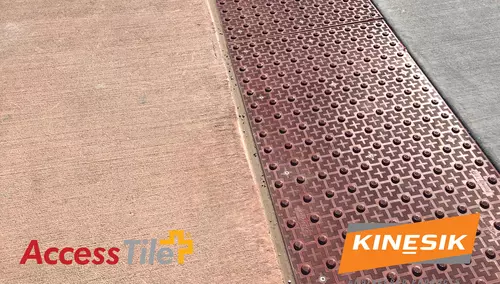
Access Tile
Introducing the Ultimate Solution in Tactile Walking Surface Indicators (TWSI). Access® Tile code compliant tactile solutions like Replaceable Cast in Place have combined proven engineered polymers, processing, and material technologies with innovative and intelligent design features to create the ultimate replaceable tactile walking surface indicators. Maximized efficiencies in manufacturing, materials sourcing, and product specifications deliver the most cost-effective solution in the industry. Access® Tile truncated domes and code-compliant wayfinding bars tiles are the industry leader for durability, weather, and wear resistance and are available as surface-applied tiles and directional bars.
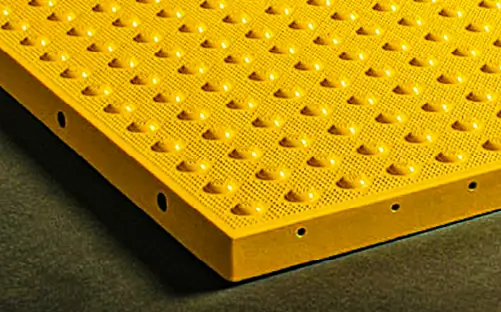
Armor Tile Tactile System
Armor-Tile offers the largest selection of Fully AODA/CSA/ISO and OBC compliant detectable tactile warning system products. These code-compliant tactile solutions are for Transit platforms, Multi-modal transit centers, Curb ramps, Stairwells, Escalator approaches, pedestrian crossings, Parking areas, Reflecting pools, and Building entrances.
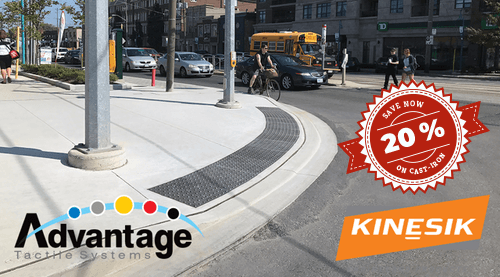
Advantage Tactile Systems
Advantage™ Cast Iron Tactile Walking Surface Indicator (TWSI) plates are manufactured in strict accordance with ASTM A-48, Class 35B Grey Cast Iron. Advantage TWSI attention tactile solutions comply with the most recent AODA, CSA, ISO, NBC, and provincial building codes.
The Advantage™ Cast in Place System Tactile Indicators in Canada are lightweight with exceptionally high strength and utilize the most advanced metallurgical Engineering Science and Technology to meet and exceed the most stringent municipal standards. Advantage™ Cast Iron Tactile Indicator Tiles are aesthetically pleasing, have exceptional longevity, and incorporate integral texture for a permanent slip-resistant surface.
Advantage ONE™ Plate and Single Domes and Bars Tactile Detectable Warning products have been designed for all interior accessibility solutions. Advantage ONE™ Tactile indicators are machined from a solid piece of 316L marine-grade Stainless Steel, which has proven to be an aesthetically pleasing, strong, and durable material. Advantage ONE™ incorporates an integral texture in the stainless steel for permanent slip resistance. Our products have undergone a rigorous series of tests to ensure that they meet guidelines developed by the ADA.

AODA-Compliant EON Tactile Tiles – Durable & Cost-Effective
Eon Tile is a durable and flexible rubber tactile attention indicator and tactile directional indicator chosen first by professionals who design and construct the finest commercial, institutional, and public environments.
Eon Tile is a state-of-the-art polymer compounded together to create category-leading quality and a contemporary look and finish.
These Tactile Walking Surface Indicators are suitable for a variety of applications such as airport concourses, railway stations, shopping centers, department stores, supermarkets, hospitals, swimming pools, schools, banks, community centers, or almost any high-traffic environment.
Eon Tile’s line of products offers tactile attention indicators (truncated domes) for warning and tactile direction indicators for way finding.
Eon Tile Tactile Solutions is part of the newest generation of excellence in warning surfaces for top-notch accessibility solutions.
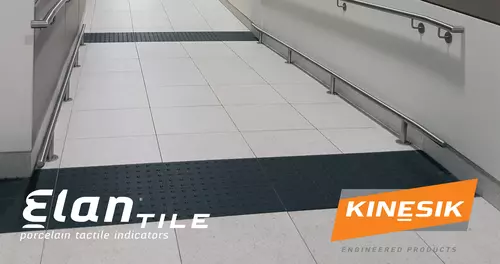
Elan Porcelain Tactile Indicators | Indoor & Outdoor Use
Elan Tile is the ultimate porcelain tactile indicators chosen by professionals who design and construct the finest commercial, institutional, and public environments.
Incorporating the finest raw materials in the industry, Elan Tile far exceeds the EN 14411 standard, allowing the product to meet the designation of “Porcelain Stoneware” and to be suitable Tactile Walking Surface Indicators for both interior and exterior applications.
Offering highly durable and versatile tactile warning surface indicators (truncated domes) for warning, and wayfinding bars indicators for direction guidance, the Elan Tile line of products signals the newest generation of excellence.
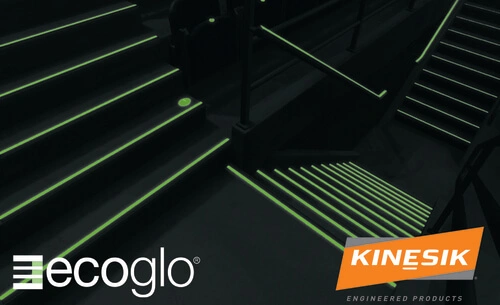
Ecoglo Stair Nosing
Ecoglo is known throughout the industry for producing a wide range of products that offer a one-stop solution for your pathfinding needs. All Ecoglo products like code compliant cast in place stair nosing and tactile strips for stairs are best-in-class and visible in all light conditions. Ecoglo’s range of emergency visibility products includes surface-applied anti-slip strips and cast-in-place star noising that are individually tested to meet the performance requirements of any performance-based building codes and designed to meet the requirements of the safety path marking guidance system. Ecoglo anti-slip stair nosing are all highly durable and tested against all-weather conditions for long-lasting anti-slip and guidance for multiple indoor and outdoor applications. Ecoglo stair safety strips provide an easy, reliable and durable solution for preventing slips and falls, illuminating pedestrians path.
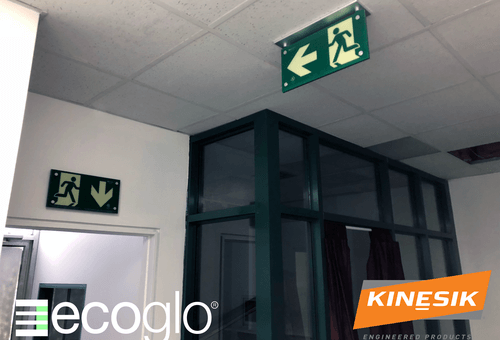
Ecoglo Directional Signage
Ecoglo is a leading global innovator of UL-certified Photoluminescent Exit Signs and Emergency Directional Exit Signage that exceed worldwide code requirements. Ecoglo’s Photoluminescent Code Compliant Exit Signs are durable against UV and all-weather conditions making them the leading solution for indoor and outdoor photoluminescent illuminated egress exit guidance system applications.
Ecoglo Photoluminescent Exit Signs and Emergency Exit Pathmarking signs are manufactured using a patented process embedding photoluminescent particles in a clear, durable polymer to ensure maximum efficiency and use a dry powder for maximum luminance. The Ecoglo Exit Signs and Pathfinding Emergency Exit sign's photoluminescent pigment allows them to be seen in all light conditions and is fast charging by natural and artificial light, making them the most cost-efficient and reliable exit sign system.
Ecoglo Photoluminescent Exit Signs:
• Multiple directions
• Choice of a universal wall mounting kit or Sign only
Ecoglo Photoluminescent Pathmarking Exit Signs:
• Multiple Directions
You realize that you need to provide a Tactile Solution for one of your projects. The solution needs to comply with the most recent AODA, CSA, ISO, Provincial and National Building Codes..
Just determine if you have to install the solution on an existing surface or into fresh concrete and if it is for indicating a danger or a safe path. Put this information into the request quote form or call us and you’ll have the right solution quoted within 24 hours
It’s easy! – Our quote includes freight cost, product availability, product data sheets, product drawings and installation instructions. Now, you are ready to implement your tactile solution efficiently, well scheduled and code compliant

All solutions offered are up-to-date code compliant with nationwide federal and provincial accessibility laws and building regulations, creating safe pathmarking guidance and attention warning detectability.

All solutions offered focus on upgrading or implementing accessibility routes. These tactile solutions provide safe accessible environments for people with vision loss. All product solutions meet the most rigorous test...

Tactile Walking Surface Indicators are perfect for any space where the safety of the visually impaired is a concern. All products are reliable, easy to install, and help prevent slips,...

stay connected to us